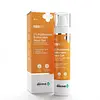What's inside
What's inside
 Key Ingredients
Key Ingredients

 Benefits
Benefits

 Concerns
Concerns

 Ingredients Side-by-side
Ingredients Side-by-side

Water
Skin ConditioningC12-15 Alkyl Benzoate
AntimicrobialEthylhexyl Methoxycinnamate
UV AbsorberDimethicone
EmollientSodium Acrylates Copolymer
Butyl Methoxydibenzoylmethane
UV AbsorberHyaluronic Acid
HumectantGlycerin
HumectantBenzophenone-3
UV AbsorberButylene Glycol
HumectantPhenoxyethanol
PreservativeLecithin
EmollientAloe Barbadensis Leaf Juice
Skin ConditioningXylitol
HumectantGlucose
HumectantSodium Levulinate
Skin ConditioningPhospholipids
Skin ConditioningPropylene Glycol
HumectantEthoxydiglycol
HumectantAnhydroxylitol
HumectantOxothiazolidine
Skin ProtectingHelianthus Annuus Seed Oil
EmollientGlyceryl Stearate
EmollientAllantoin
Skin ConditioningTocopheryl Acetate
AntioxidantPhoenix Dactylifera Seed Extract
MoisturisingVaccinium Corymbosum Seed
AbrasiveVaccinium Angustifolium Fruit Extract
Skin ProtectingCitrus Paradisi Fruit Extract
Skin ConditioningZinc Oxide
Cosmetic ColorantCyclopentasiloxane
EmollientPEG-10 Dimethicone
Skin ConditioningAscorbic Acid
AntioxidantC9-12 Alkane
SolventHydrogen Dimethicone
Titanium Dioxide
Cosmetic ColorantAluminum Hydroxide
EmollientPolyhydroxystearic Acid
EmulsifyingWater, C12-15 Alkyl Benzoate, Ethylhexyl Methoxycinnamate, Dimethicone, Sodium Acrylates Copolymer, Butyl Methoxydibenzoylmethane, Hyaluronic Acid, Glycerin, Benzophenone-3, Butylene Glycol, Phenoxyethanol, Lecithin, Aloe Barbadensis Leaf Juice, Xylitol, Glucose, Sodium Levulinate, Phospholipids, Propylene Glycol, Ethoxydiglycol, Anhydroxylitol, Oxothiazolidine, Helianthus Annuus Seed Oil, Glyceryl Stearate, Allantoin, Tocopheryl Acetate, Phoenix Dactylifera Seed Extract, Vaccinium Corymbosum Seed, Vaccinium Angustifolium Fruit Extract, Citrus Paradisi Fruit Extract, Zinc Oxide, Cyclopentasiloxane, PEG-10 Dimethicone, Ascorbic Acid, C9-12 Alkane, Hydrogen Dimethicone, Titanium Dioxide, Aluminum Hydroxide, Polyhydroxystearic Acid
Butyl Methoxydibenzoylmethane 3%
UV AbsorberHomosalate 10%
Skin ConditioningEthylhexyl Salicylate 5%
UV AbsorberOctocrylene 10%
UV AbsorberWater
Skin ConditioningStyrene/Acrylates Copolymer
Silica
AbrasiveDimethicone
EmollientPotassium Cetyl Phosphate
EmulsifyingBenzyl Alcohol
PerfumingBeeswax
Emulsion StabilisingCaprylyl Methicone
Skin ConditioningGlyceryl Stearate
EmollientPEG-100 Stearate
Cetyl Dimethicone
EmollientCaprylyl Glycol
EmollientEthylhexylglycerin
Skin ConditioningAluminum Starch Octenylsuccinate
AbsorbentBehenyl Alcohol
EmollientAcrylates/Dimethicone Copolymer
Skin ConditioningXanthan Gum
EmulsifyingSodium Polyacrylate
AbsorbentChlorphenesin
AntimicrobialDimethicone/PEG-10/15 Crosspolymer
Hydrolyzed Jojoba Esters
Skin ConditioningParfum
MaskingDisodium EDTA
Ethylhexyl Stearate
EmollientTocopheryl Acetate
AntioxidantBHT
AntioxidantTrideceth-6
EmulsifyingJojoba Esters
EmollientButyl Methoxydibenzoylmethane 3%, Homosalate 10%, Ethylhexyl Salicylate 5%, Octocrylene 10%, Water, Styrene/Acrylates Copolymer, Silica, Dimethicone, Potassium Cetyl Phosphate, Benzyl Alcohol, Beeswax, Caprylyl Methicone, Glyceryl Stearate, PEG-100 Stearate, Cetyl Dimethicone, Caprylyl Glycol, Ethylhexylglycerin, Aluminum Starch Octenylsuccinate, Behenyl Alcohol, Acrylates/Dimethicone Copolymer, Xanthan Gum, Sodium Polyacrylate, Chlorphenesin, Dimethicone/PEG-10/15 Crosspolymer, Hydrolyzed Jojoba Esters, Parfum, Disodium EDTA, Ethylhexyl Stearate, Tocopheryl Acetate, BHT, Trideceth-6, Jojoba Esters
 Reviews
Reviews

Ingredients Explained
These ingredients are found in both products.
Ingredients higher up in an ingredient list are typically present in a larger amount.
Also known as Avobenzone, this ingredient is a chemical sunscreen filter that provides protection in the UV-A range.
Avobenzone is globally approved and is the most commonly used UV-A filter in the world.
Studies have found that avobenzone becomes ineffective when exposed to UV light (it is not photostable; meaning that it breaks down in sunlight). Because of this, formulations that include avobenzone will usually contain stabilizers such as octocrylene.
However, some modern formulations (looking at you, EU!) are able to stabilize avobenzone by coating the molecules.
Avobenzone does not protect against the UV-B range, so it's important to check that the sunscreen you're using contains other UV filters that do!
The highest concentration of avobenzone permitted is 3% in the US, and 5% in the EU.
Learn more about Butyl MethoxydibenzoylmethaneDimethicone is a type of synthetic silicone created from natural materials such as quartz.
What it does:
Dimethicone comes in different viscosities:
Depending on the viscosity, dimethicone has different properties.
Ingredients lists don't always show which type is used, so we recommend reaching out to the brand if you have questions about the viscosity.
This ingredient is unlikely to cause irritation because it does not get absorbed into skin. However, people with silicone allergies should be careful about using this ingredient.
Note: Dimethicone may contribute to pilling. This is because it is not oil or water soluble, so pilling may occur when layered with products. When mixed with heavy oils in a formula, the outcome is also quite greasy.
Learn more about DimethiconeGlyceryl Stearate is a mix of glycerin and stearic acid.
It is used to stabilize the mixing of water and oil ingredients. By preventing these ingredients from separating, it can help elongate shelf life. It can also help thicken the product's texture.
As an emollient, it helps soften skin and supports barrier-replenishing ingredients.
In cosmetics, Glyceryl Stearate is often made from vegetable oils or synthetically produced.
This ingredient may not be fungal-acne safe
Fun fact: The human body also creates Glyceryl Stearate naturally.
Learn more about Glyceryl StearateTocopheryl Acetate is AKA Vitamin E. It is an antioxidant and protects your skin from free radicals. Free radicals damage the skin by breaking down collagen.
One study found using Tocopheryl Acetate with Vitamin C decreased the number of sunburned cells.
Tocopheryl Acetate is commonly found in both skincare and dietary supplements.
Learn more about Tocopheryl AcetateWater. It's the most common cosmetic ingredient of all. You'll usually see it at the top of ingredient lists, meaning that it makes up the largest part of the product.
So why is it so popular? Water most often acts as a solvent - this means that it helps dissolve other ingredients into the formulation.
You'll also recognize water as that liquid we all need to stay alive. If you see this, drink a glass of water. Stay hydrated!
Learn more about Water